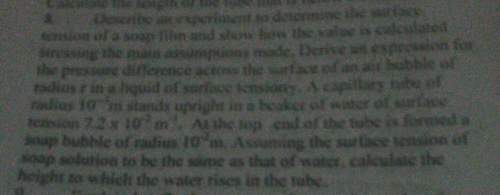
Physics, 29.01.2021 21:20 TheOneandOnly003
An object is thrown with a horizontal velocity (Vh) of 15.0 mt/sec and an initial vertical velocity (Vi) of 29.4 mt/sec. How long with the object take to reach its maximum height and start to return to the earth?
(A) 3 Seconds. The maximum height refers to the vertical direction and this question asks how long it will take the object to reach that maximum height. In the vertical direction we know the Vi = 29.4 mt/sec and the Vf = 0 when the object reaches its maximum height. We also know that vertical motion is free-fall motion and is subject to an acceleration due to gravity of -9.8 mt/sec. Using our kinematic motion equation t = (Vf – Vi)/g, we can calculate the time to reach maximum height as 3 seconds.
(B) 44.1 meters. The maximum height refers to the vertical direction and this question asks what is that maximum height. In the vertical direction we know the Vi = 29.4 mt/sec and the Vf = 0 when the object reaches its maximum height. We also know that vertical motion is free-fall motion and is subject to an acceleration due to gravity of -9.8 mt/sec.
Using our kinematic motion equations where the maximum height is referred to as the displacement (d), we can use the “no time” equation ---Vf2 = Vi2 + 2gd, we can calculate the maximum height as 44.1 meters
(C) 6 seconds. The time that the object takes to return to the ground is essentially double the time it takes to reach the maximum height or double the time it takes to travel from its maximum height back to the ground (what goes up, must come down). Since maximum height refers to the vertical direction, we know the Vi = 29.4 mt/sec and the Vf = 0 when the object reaches its maximum height. We also know that vertical motion is free-fall motion and is subject to an acceleration due to gravity of -9.8 mt/sec. Going up: Using our kinematic motion equation t = (Vf – Vi)/g, we can calculate the time to reach maximum height as 3 seconds. The time to return would be another 3 seconds for a total of 6 seconds.
Going down: Using the same kinematic motion equation (which is applicable to upwards and downward motion) we can calculate the time to return to the earth from the maximum height as 3 seconds. The time to reach maximum height would be another 3 seconds for a total of 6 seconds.
(D) 90 meters. The distance traveled refers to the horizontal direction and this question asks how far the object will travel horizontally while “going up and coming down” in the vertical direction. With the exception of the identical time, there is no connection between the vertical and horizontal motion. To find the horizontal distance traveled use the kinematic equation d = Vh * t + ½ (at2) but since there is no acceleration in the horizontal direction, d = Vh * t. We need to calculate the time it takes the object to go “up and down vertically” to complete this calculation.
Going up: Using our kinematic motion equation t = (Vf – Vi)/g, we can calculate the time to reach maximum height as 3 seconds. The time to return would be another 3 seconds for a total of 6 seconds.
Going down: Using the same kinematic motion equation (which is applicable to upwards and downward motion) we can calculate the time to return to the earth from the maximum height as 3 seconds. The time to reach maximum height would be another 3 seconds for a total of 6 seconds. Using this value for the total time, d = 15.0 * 6 = 90 meters
(E) Cannot be determined. It is impossible to calculate the answer based on the information provided.

Answers: 3


Another question on Physics

Physics, 22.06.2019 07:50
Calculate the ratio of h+ ions to oh– ions at a ph = 6. find the concentration of h+ ions to oh– ions listed in table b of your student guide. then divide the h+ concentration by the oh– concentration. record this calculated ratio in table a of your student guide. compare your approximated and calculated ratios of h+ ions to oh– ions at a ph = 6. are they the same? why or why not? record your explanation in table a. what is the concentration of h+ ions at a ph = 6? mol/l what is the concentration of oh– ions at a ph = 6? mol/l what is the ratio of h+ ions to oh– ions at a ph = 6? : 1
Answers: 1

Physics, 22.06.2019 17:30
Patricia is trying to compare the average rainfall of new york to that of arizona. a comparison between these two states for the months of july through september would best be measured in
Answers: 3

Physics, 22.06.2019 22:00
Will mark brainliest! asap! ! 16) which of the clouds shown would indicate a possible future rain storm? a) b) c) d)
Answers: 1

Physics, 22.06.2019 22:30
Which is a substance that can be separated by physical means and is not the same throughout
Answers: 2
You know the right answer?
An object is thrown with a horizontal velocity (Vh) of 15.0 mt/sec and an initial vertical velocity...
Questions

Mathematics, 19.07.2019 00:30

Mathematics, 19.07.2019 00:30


Social Studies, 19.07.2019 00:30


Mathematics, 19.07.2019 00:30

Advanced Placement (AP), 19.07.2019 00:30

Computers and Technology, 19.07.2019 00:30

Social Studies, 19.07.2019 00:30


Mathematics, 19.07.2019 00:30

Mathematics, 19.07.2019 00:30

Computers and Technology, 19.07.2019 00:30


Computers and Technology, 19.07.2019 00:30

Health, 19.07.2019 00:30

Computers and Technology, 19.07.2019 00:30

Mathematics, 19.07.2019 00:30


Computers and Technology, 19.07.2019 00:30




